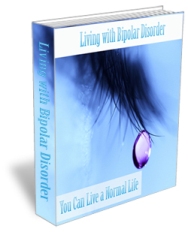|
Bipolar Disorder Guide
Bipolar Disorder Articles
Home
A Bipolar Disorder Checklist to Identify the Symptoms
A Bipolar Disorder Diagnosis is Difficult to Make
A Bipolar Quiz Helps Diagnose if the Disorder is Present
A Bipolar Test Will Identify the Severity of the Disorder
Bipolar Disease Has Many Extreme Levels
Bipolar Disorder in Children Can Present Different Than in Adults
Bipolar Medications Must be Carefully Monitored
Bipolar Symptoms For the Awareness of the Bipolar Disorder
Bipolar Treatment Through Medication and Counseling
Dealing with Bipolar Disorder Takes Time and Patience
The Behaviors of Bipolar Disorder are Disruptive to Everyone
The Chemistry of Bipolar Disorder is an Ongoing Study
The Family Suffers When a Mother Has Bipolar Disorder
The History of Bipolar Disorder Shows It Has Always Existed
The Relationship of Bipolar and Depression
The Types of Bipolar Support Programs That Can Help

CLICK
HERE
To Learn More
Related Links
HealthDuties
|
A Bipolar Disorder Checklist to Identify the Symptoms
Diagnosis of bipolar disorder is not an easy task and to
correctly determine the exact medical condition of the patient, psychiatrists carry out a number of tests. Physical as well as
psychiatric examinations are conducted to rule out the possibility of any other disorder.
To arrive at the correct decision regarding diagnosis, various bipolar disorder checklists are used
by doctors. The first step to be followed consists of checking whether the individual is experiencing extreme mood swings from
hyperactivity to acute depression. While it is difficult for the patient to gauge the mood swings, a family member can feel the
difference with a little bit of care and effort. Therefore, bipolar diagnosis also depends on the feedback received from family
members or other people surrounding the individual suffering from the disorder. In order to identify the bipolar symptoms
it is essential to look for certain moods, physical symptoms, behavior and thinking patterns, and
change in senses.
The bipolar disorder checklist that describes the manic or hyperactive phase can consist of euphoric or
abnormally elevated moods. The individual may be easily irritable, argumentative or even excessively stubborn. Insomnia, sudden
weight loss or increased appetites are some of the physical symptoms of the manic phase.
Behavior patterns also change and the individual might become impulsive, intrusive or reckless. Disorganized
behaviour, distraction from work, blaming others without reason, excessive anger are some of the symptoms of the manic phase.
During this phase the individual’s thinking pattern changes and there is a rapid shift of attention, poor concentration, memory
distortion, and sometimes delusions, especially in the acute stage of bipolar disorder. Sensitivity towards heat, cold and hunger
changes along with other mental shifts like having hallucinations. If a combination of the various symptoms in each category is
observed in an individual for over a week, medical attention should be sought and identification of the disorder is
possible.
Similarly the bipolar disorder checklist marks the depressive phase. The
changes in mood consist of feelings of sadness, grief, loneliness and irritability. There is also a lack of interest in the daily
activities. Insomnia or excessive sleep, increased or decreased appetite, extreme fatigue and loss of energy are some of the
physical symptoms noticed during this phase. The behavior of the individual also changes and performance levels drop. There is a
lack of motivation and increased feelings of isolation. The individual loses the desire to talk, interact or socialize with
others at work or home.
Along with changes in the thinking pattern, the patient develops hypersensitivity towards noise, light, stress
and often experiences hallucinations in the psychotic stage of the disorder. If a combination of the various symptoms persists
for at least 2 weeks as defined by the bipolar disorder checklist, the individual can be diagnosed with the disorder. However,
the checklist only provides a guideline for diagnosis of the disease and doctors should be consulted before arriving at a
decision.
|